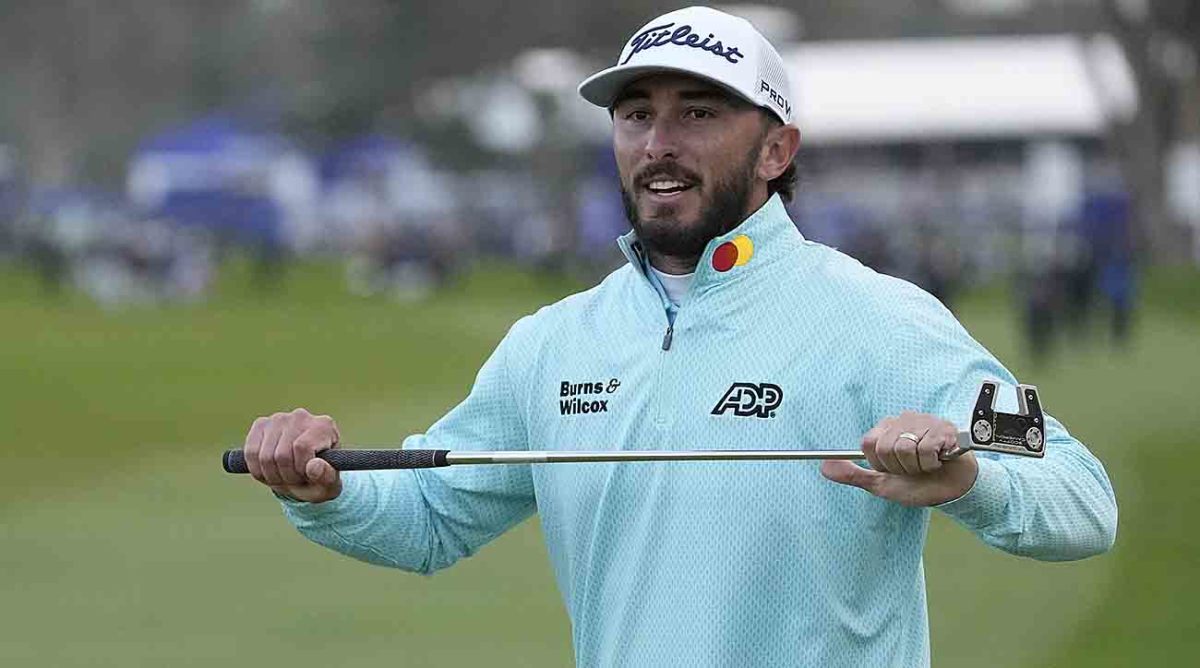With an In-Round Interview, TV Golf Tried Something New and It Succeeded

Amid the mindless array of dugout chats, courtside confabs and hasty halftime briefings, network television broke new ground last week in its quest to take viewers closer to the action. Max Homa, who would go on to win the PGA Tour event at Torrey Pines, agreed to wear an audio device during the tournament’s third round, which allowed CBS to interview him while he played the 13th hole. This wasn’t some ephemeral hit-and-run with Nick Saban as he jogged off the field or 30 seconds of attempted conversation with an uncooperative Gregg Popovich.
Because Homa is such a nice guy—and because the 13th at Torrey Pines is a par 5 measuring 621 yards—the dialogue lasted for 10 or 12 minutes. A relatively poor second shot during this period left Homa with what he thought was a plugged lie on the steep bank fronting the green. He asked for a ruling and was quickly accommodated, which made CBS’s communication with him slightly more interesting. Upon getting relief and chopping his ball onto the putting surface, Homa’s repartee with lead analyst Trevor Immelman came to an end.
In case you missed mic'd up @maxhoma23 🎤
— Golf on CBS ⛳ (@GolfonCBS) January 28, 2023
Here's our Max Rewind ⏮ pic.twitter.com/nV4gMDAIqE
Although it lacked the historical significance of Neil Armstrong setting foot on the Moon or the dramatic fireworks of the 1986 Masters, Homa's willingness to avail himself to the public in live competition was an advancement of a component TV producers turned into a visual cliche long ago. Sideline interviews are worthless. Have been for decades. No coach in his right mind is going to say anything insightful or revealing, even if a pretty young lady comes up and sticks a microphone in his face on his way to the locker room.
To hear from an actual participant in an athletic contest during play, however, is both highly unique and indigenous to golf—a game where waiting and walking comprise a gigantic percentage of the overall activity. Tour pros have a whole bunch of time to talk, but in deference to the importance of them concentrating on the task at hand, any thought of doing what CBS did with Homa has always been considered taboo. Dude is out there trying to make a living. Don’t even think about interrupting him.
Not that Homa said anything close to memorable or broke off a couple of one-liners zesty enough to leave Aunt Gertrude rolling on the floor. It was nothing more than improved access for those watching at home, and in this case, nothing means everything. Afterward, CBS dropped hints that it would continue to pursue in-round interviews on a regular basis, a project not only contingent on the consent of the players, but the selection of guys with enough star power and personality to make those 10 minutes worthwhile.

Jordan Spieth would be nice—anyone who talks so often to his golf ball would make for an ideal candidate to share his post-shot thought process with the audience. That said, club-bangers such as Justin Thomas or Jon Rahm could easily prove to be hit or miss. Given how intensity is amplified considerably in the final round, this is very likely to become a Saturday thing, a tiny sliver of irony coming from the Tour’s decision to move Torrey Pines up a day so it would avoid clashing with the NFL’s conference championships.
That’s another idea worth exploring. Why doesn’t Camp Ponte Vedra finish the first five or six tournaments of the calendar year on Saturday to dodge the viewership hog run by Roger Goodell? Tour commissioner Jay Monahan pushed the FedEx Cup playoffs back into August as a means of ducking the power of the pigskin, but for some reason, hasn’t done the same with tournaments that have no chance of competing against the NFL’s postseason. Not that Honolulu or Palm Springs would instantly turn into ratings goldmines, but why pick a fight with someone you can’t beat?
From there, the box is open and the game’s other heads of state would be encouraged to think outside of it. The LPGA should at least experiment with a Wednesday-to-Saturday structure, if not Tuesday to Friday, the logical premise being that golf fans are a provincial bunch who would greatly prefer watching the world’s best female players over anything else on a weekday afternoon. It’s not as if Golf Channel doesn’t have room in its programming schedule to accommodate such a shift, nor would it despise the idea that its audience would slowly but surely grow if given the opportunity.
The same goes for the seniors. Whether it can eventually influence viewer habits is anyone’s guess, but LIV Golf’s new deal with the CW Network makes it a product that must be acknowledged, if not reckoned with. There’s another performer on the playbill, even it it’s at the bottom, meaning the game’s core constituency has another option when it turns on the TV. Anyone who thinks the LPGA or PGA Tour Champions would struggle to adjust their infrastructures by moving away from weekend competition, notably in retaining the current allotment of tournament volunteers, is driving into the future with their eyes closed.
Pro golf is a television sport first, a spectator sport second. Today’s reason for change is tomorrow’s cause of growth.
